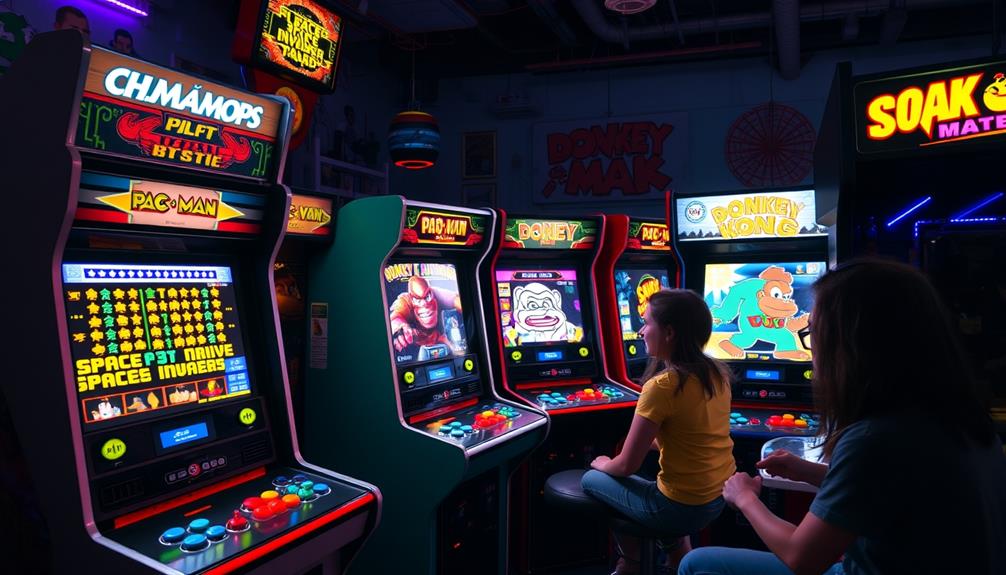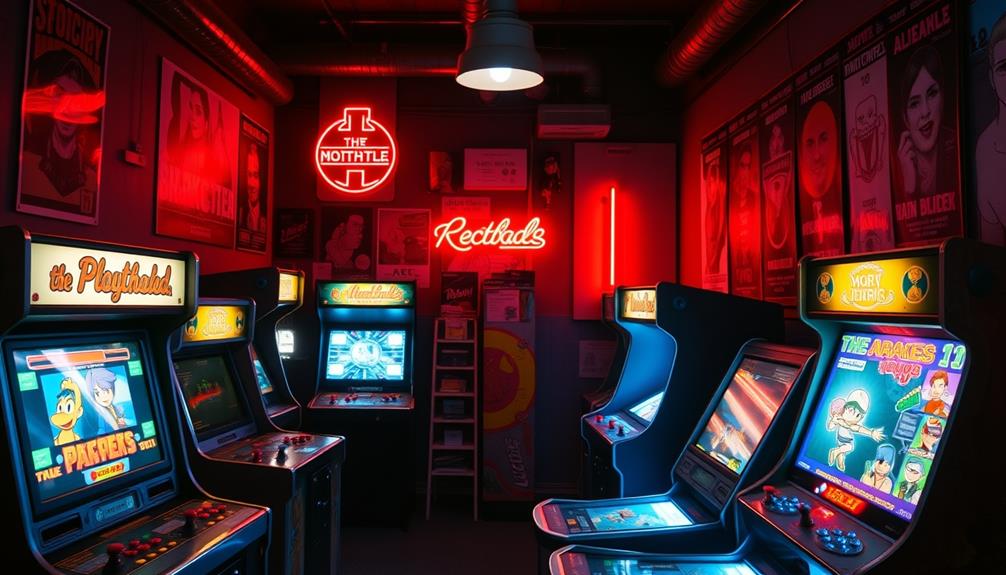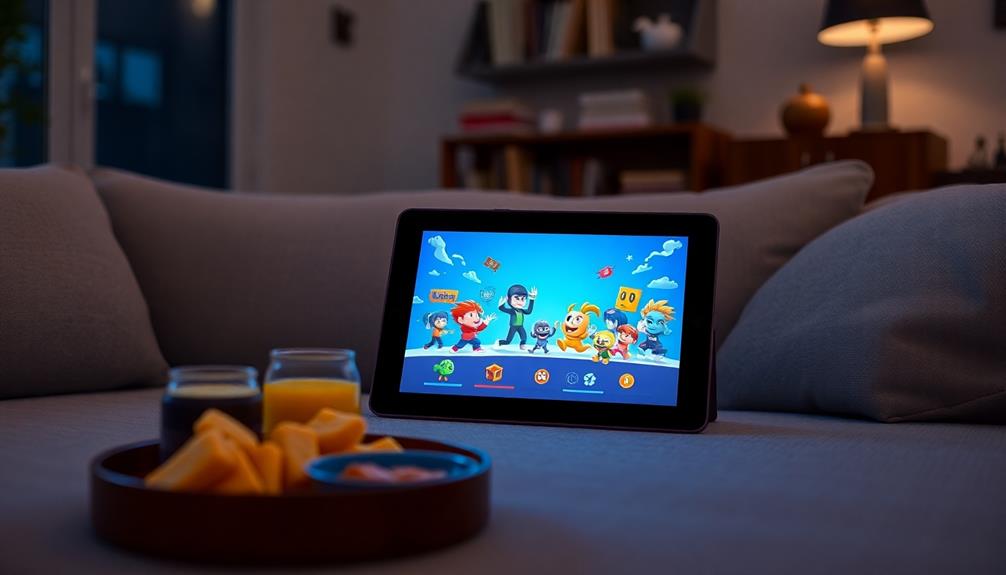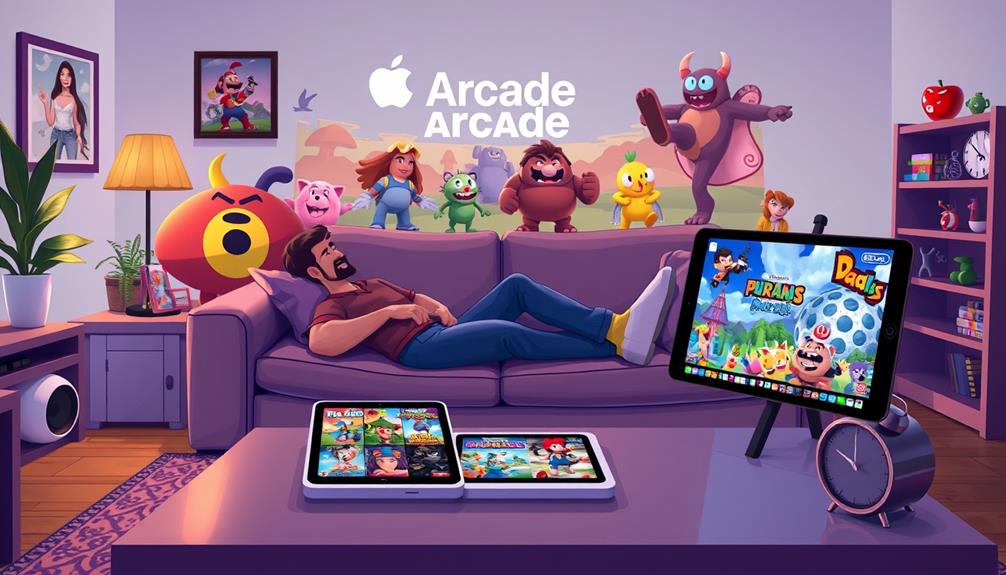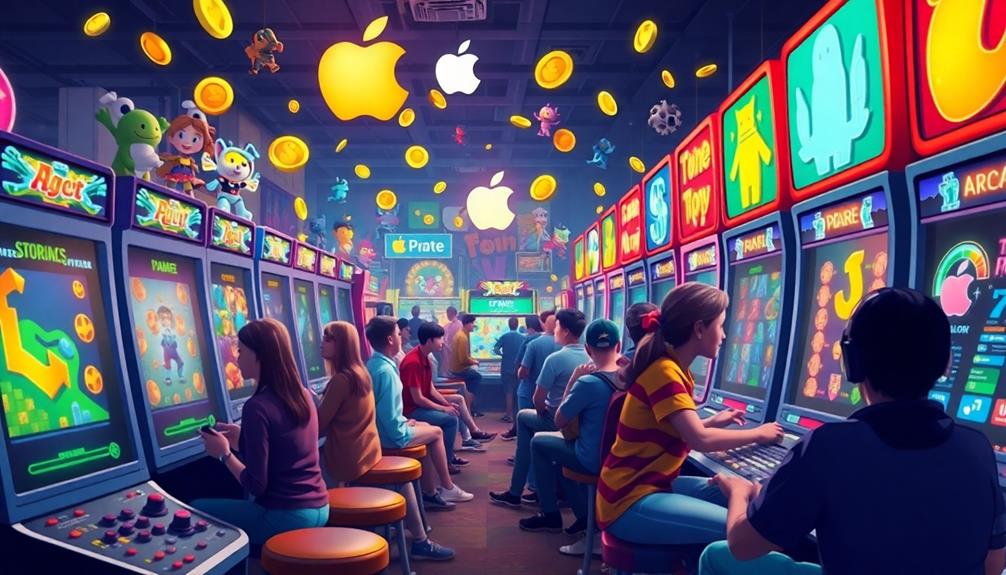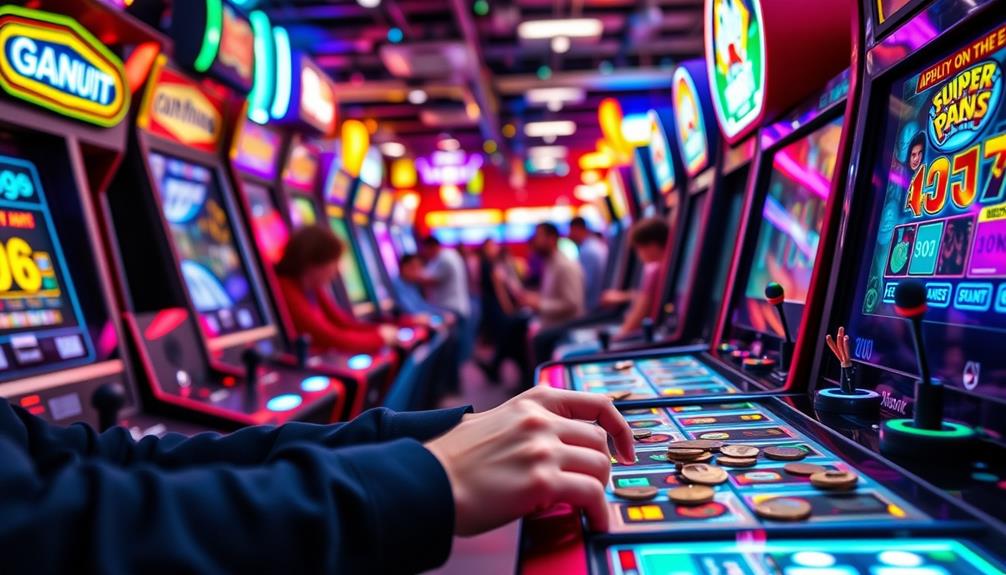If you are interested in classic arcade games, you cannot overlook iconic titles such as Pac-Man, Donkey Kong, and Galaga. Pac-Man changed the gaming industry with its maze-chase gameplay, while Donkey Kong introduced players to the popular character Mario. Games like Ms. Pac-Man and Street Fighter II further influenced the genre, providing new challenges and gameplay variations. Remember the excitement of multiplayer gaming with titles like Teenage Mutant Ninja Turtles and The Simpsons? Each game brought unique ideas that captivated players. Continue exploring to uncover more hidden gems and legendary titles from the arcade era.
Key Takeaways
- Pac-Man (1980): A revolutionary maze chase game that became a cultural icon and merchandise phenomenon.
- Donkey Kong (1981): Introduced character-driven narratives and established Mario as a key figure in gaming.
- Ms. Pac-Man (1981): Enhanced the original with new mazes and enemy behaviors, adding strategic depth.
- Galaga (1981): A classic shooter that improved upon its predecessor, Galaxian, with engaging gameplay mechanics.
- Street Fighter II (1991): Defined competitive gaming with its diverse character roster and multiplayer dynamics.
Overview of Classic Arcade Games
Classic arcade games represent a pivotal era in gaming history, with over 500 titles released between 1977 and 1997 that showcase the medium's evolution. You can trace the roots of modern gaming back to these iconic titles, which laid the groundwork for various genres. One of the most influential classic arcade games from this era is the classic galaga arcade machine. It popularized the space shooter genre and introduced innovative mechanics that would be emulated in countless future games. The impact of these classic arcade games is still felt in the industry today, with many modern games paying homage to their roots with nostalgic nods and references.
Games like Ms. Pac-Man, Donkey Kong, and Galaga not only became cultural touchstones but also influenced gameplay mechanics and storytelling in ways you mightn't even realize. Additionally, many of these classics have inspired modern adaptations and remakes, reflecting their lasting impact on the gaming landscape. The nostalgia surrounding these games has prompted a resurgence in interest, with collectors and enthusiasts seeking out original arcade machines for their home game rooms, as seen in the Best Arcade Machines for Home Game Rooms.
The shift from simple gameplay concepts to more complex experiences is evident in these classic arcade games. As you play, you'll notice how they introduced challenges and strategies that still resonate today.
Thanks to emulators like MAME, you can easily access the Best Classic Arcade Games and experience them firsthand, whether you're a retro gamer or a newcomer.
Nostalgia plays a significant role in their appeal, too. As you immerse yourself in these classics, you'll likely feel a sense of connection to previous generations who shared similar experiences. This shared joy keeps classic arcade games alive, allowing you to bond with friends and family over timeless entertainment.
Iconic Characters in Arcade History
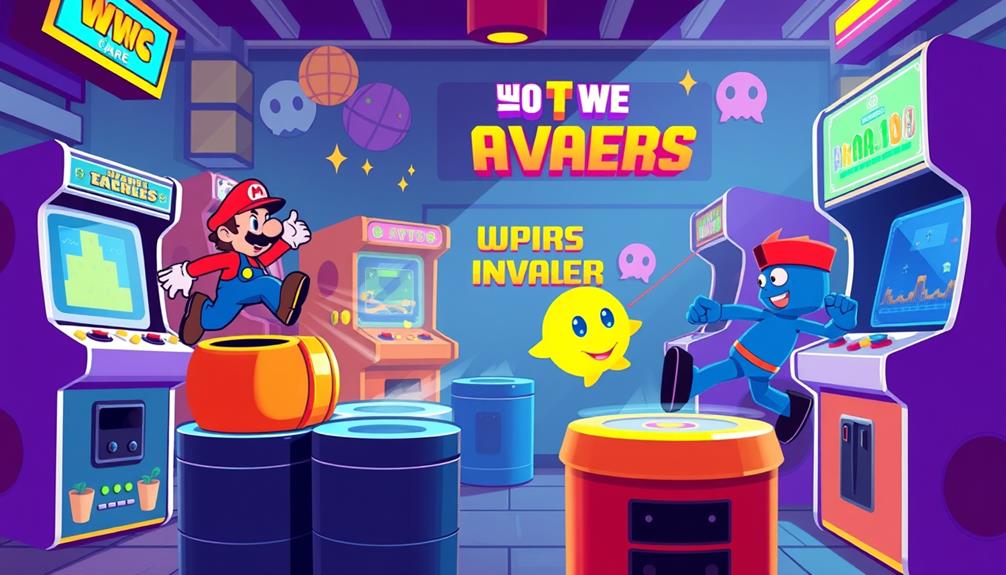
When you think of classic arcade games, iconic characters like Mario and Pac-Man immediately come to mind.
These characters not only shaped their games but also left a lasting cultural impact that resonates with players today.
The history of arcade games, much like that of pinball machines, showcases the evolution of gameplay mechanics and design innovation.
Let's explore how these beloved figures transformed the arcade landscape and became symbols of gaming itself.
Iconic Game Characters
Arcade history is filled with iconic game characters that have left a lasting impact on the industry and gamers alike. You can't talk about this legacy without mentioning a few key figures who shaped the landscape of gaming. The resilience of these characters parallels the triumphs seen in celebrity transformations, such as Caleb Coffee's survival after a dangerous fall, showcasing the strength of overcoming challenges.
- Mario, introduced in *Donkey Kong* (1981), transformed into a symbol of the gaming industry, spawning countless sequels and spin-offs.
- Pac-Man, launched in 1980, revolutionized gaming with its non-violent maze chase, cultivating a massive fanbase and merchandise frenzy.
- Ms. Pac-Man, hitting the arcade scene in 1981, enhanced the original with new mazes and clever enemies, solidifying her status in arcade history.
Then there's Donkey Kong himself, the character who started it all. His rivalry with Mario not only defined their narratives but also set the stage for future character interactions in games.
Don't forget about the ghosts from *Pac-Man*—Blinky, Pinky, Inky, and Clyde—who added depth and strategy to the gameplay with their unique chasing patterns.
These iconic game characters continue to resonate with players, reminding us of the magic of arcade gaming.
Cultural Impact of Characters
Throughout gaming history, iconic characters haven't only defined their respective games but also influenced broader cultural trends. Take Mario, for example. His debut in Donkey Kong (1981) established him as a central figure in Nintendo's universe, shaping the platforming genre.
This character-driven success is mirrored in other industries, such as precious metal investments, where companies like Noble Gold have built strong reputations through quality service and transparency.
Then there's Pac-Man, who became a cultural phenomenon in 1980. His non-violent gameplay approach led to an explosion of merchandise and adaptations, proving that arcade characters could transcend the screen.
Ms. Pac-Man improved upon the original, introducing randomized ghost movements and solidifying her status as a beloved character.
The Teenage Mutant Ninja Turtles (1989) showcased how characters from animated series could thrive in arcade environments, promoting cooperative gameplay and demonstrating the power of cross-media success.
Street Fighter II (1991) took this further by introducing a diverse cast of characters, which not only defined the fighting genre but also fostered a dedicated competitive gaming community.
These arcade characters have become symbols of their eras, influencing not just gaming but also fashion, toys, and even TV shows, proving that their impact goes far beyond the arcade.
Multiplayer Gaming Experiences

When you think about multiplayer gaming experiences, cooperative gameplay dynamics really stand out. Titles like Teenage Mutant Ninja Turtles and The Simpsons let you team up with friends, making each session a shared adventure.
These iconic games not only entertained but also created lasting memories through collaboration and teamwork, much like the emotional speeches at Paula Deen's Wedding Highlights that resonated with attendees.
The camaraderie and shared excitement in gaming mirror the joy found in special moments, whether in a pixelated world or at a heartfelt event.
Cooperative Gameplay Dynamics
Classic arcade games have a special charm that brings friends together through cooperative gameplay dynamics. These games foster a sense of teamwork, allowing you and your pals to join forces and tackle challenges together.
The thrill of working together to achieve a common goal creates memorable gaming experiences, much like how astrological compatibility may enhance interpersonal attraction in social settings astrological influence on charm.
Here are a few standout examples of cooperative play in classic arcade games:
- Teenage Mutant Ninja Turtles (1989): Team up as your favorite turtles in this four-player adventure, fighting against the forces of evil.
- The Simpsons (1991): Jump into a hilarious beat 'em up where up to four players can join in the fun and save Springfield.
- X-Men (1992): Experience revolutionary gameplay with the ability to accommodate up to six players, enhancing the excitement with dual screens.
These arcade games highlight how cooperative play not only elevates the fun but also encourages social interaction.
Whether it's sharing magical powers in Golden Axe (1989) or strategizing how to defeat enemies, these dynamics make classic arcade games a beloved choice for friends and family alike.
Iconic Multiplayer Titles
The excitement of multiplayer gaming experiences in classic arcade titles often leaves a lasting impression on players. You might remember teaming up with friends in Teenage Mutant Ninja Turtles (1989), where you fought against enemies as your favorite turtle, enjoying the vibrant visuals reminiscent of the animated series. Engaging in these games can even enhance your social connections, similar to how coffee culture fosters community through shared experiences.
Then there's The Simpsons (1991), a hilarious 4-player beat 'em up that let you play as Homer, Marge, Bart, or Lisa, making it a staple of arcade gaming with its engaging gameplay.
If you craved a larger party, X-Men (1992) allowed up to six players to join forces on dual screens, each character boasting unique powers. For those who enjoyed fantasy, Golden Axe (1989) offered cooperative hack-and-slash action, where you could choose characters with magical abilities to conquer enemies.
Finally, Gauntlet (1985) emphasized teamwork, letting up to four players navigate dungeon levels filled with foes and treasures.
These iconic multiplayer titles not only brought friends together but also created unforgettable gaming memories, showcasing the best of arcade gaming. So, gather your pals and relive those classic moments!
Innovative Gameplay Mechanics
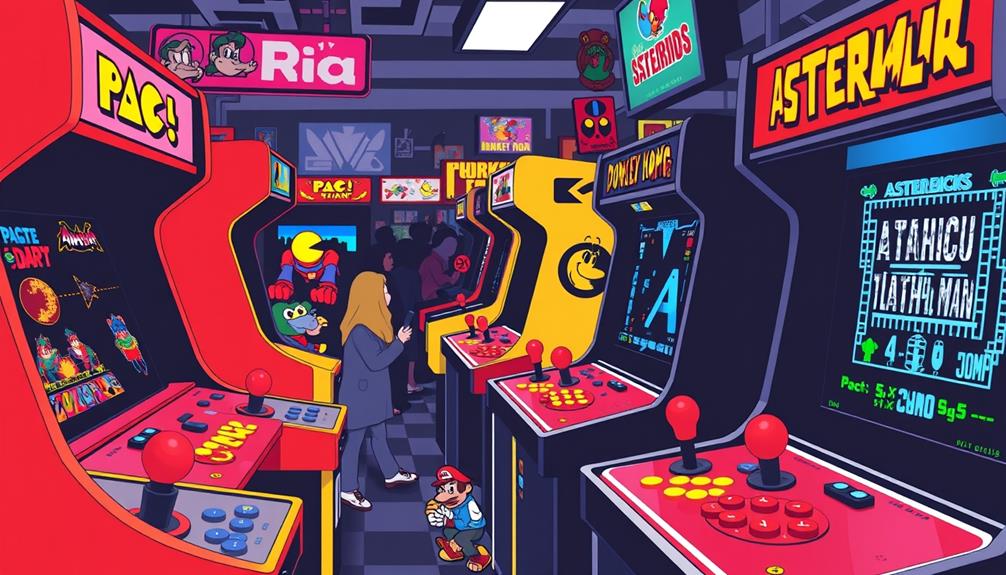
Innovative gameplay mechanics have profoundly shaped the arcade gaming experience, pushing boundaries and enchanting players. These mechanics have fostered a sense of community and engagement, as players gather around machines to enjoy the thrilling challenges together.
From cooperative strategies to unique controls, these mechanics have redefined what arcade action can be. Take a look at some standout examples:
- Defender (1981): This game melded Asteroids and Space Invaders, requiring you to protect human populations from alien invaders while maneuvering a horizontally scrolling environment.
- Ikari Warriors (1986): You'll find dual-stick shooting mechanics here, allowing for cooperative maneuvering through enemy territory, emphasizing teamwork and strategic movement.
- Guitar Freaks (1998): This game shifted the focus from real musicianship to button pressing, sparking the rise of music rhythm games in arcades.
These innovative gameplay mechanics not only provided fresh challenges but also encouraged social interaction and competition among players.
Titles like Joust (1982) and Time Crisis II (1997) further pushed the envelope, with competitive multiplayer setups and tactical elements that made every session thrilling.
Fundamentally, these games not only entertained but also transformed the expectations of arcade action, leaving a lasting legacy in gaming history.
Discover more about user engagement in the context of gaming experiences.
Lightgun and Shooting Games
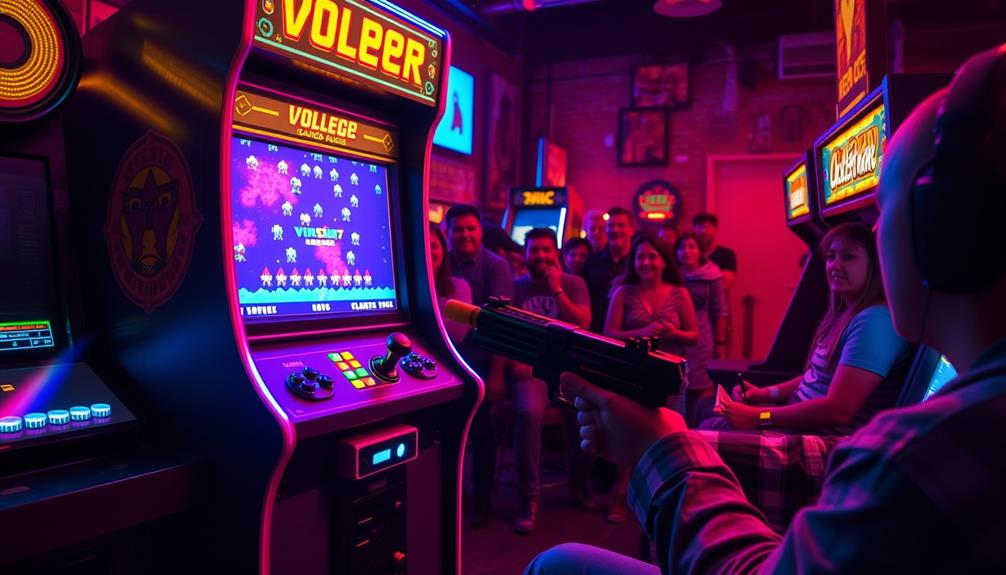
Arcade gaming took a thrilling turn with the introduction of lightgun and shooting games, transforming how players interacted with their favorite titles. These games offered immersive experiences and fast-paced gameplay that kept players on the edge of their seats.
Notable Lightgun Games
| Game Title | Year Released | Key Features |
|---|---|---|
| Jurassic Park: The Lost World | 1997 | Shoot dinosaurs with cutting-edge visuals |
| Time Crisis II | 1997 | Foot pedal for cover and cooperative play |
| House of the Dead 2 | 1998 | Horror theme with memorable voice acting |
Lightgun games like Duck Hunt and Gunsmoke laid the groundwork for this genre, allowing players to aim at on-screen targets. As you progressed, titles like Virtua Cop 2 introduced branching paths, requiring precision shooting to navigate levels effectively. The evolution of these games not only enhanced the gaming experience but also attracted large crowds to arcades.
With every pull of the trigger, players explored deeper into thrilling worlds, forever changing the landscape of arcade gaming. Whether you faced dinosaurs or zombies, the adrenaline rush of lightgun games became a staple in arcade culture.
Classic Arcade Shooters
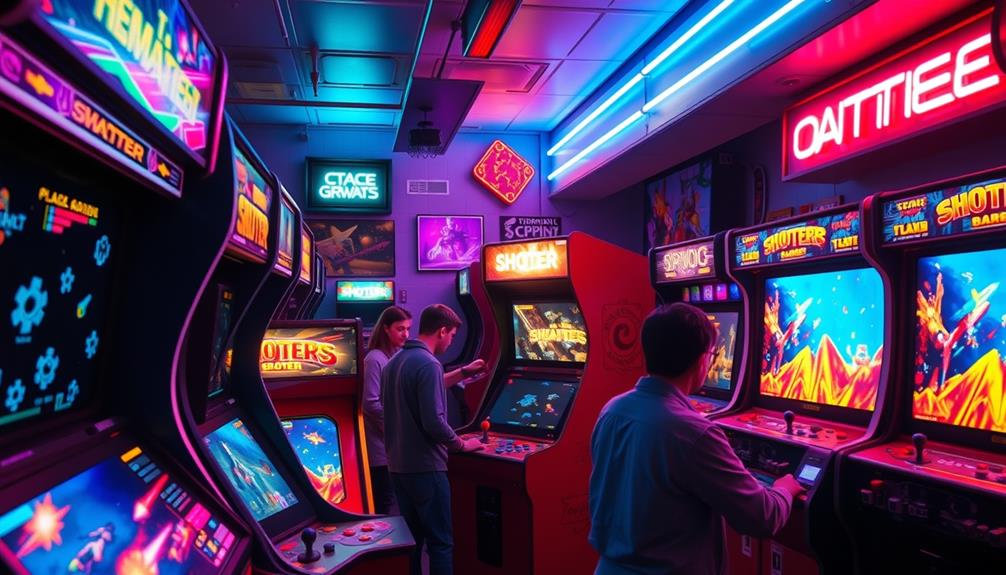
When you think of classic arcade shooters, iconic titles like Galaxian and R-Type probably come to mind.
Each game introduced gameplay innovations that not only defined the genre but also set the stage for future shooters.
Significantly, the thrilling mechanics of these games resonate with the excitement found in modern pinball experiences, where advanced technology and design create unforgettable entertainment best rated pinball machines.
Let's explore how these classics shaped the arcade landscape and what made them unforgettable.
Iconic Shooter Titles
Plunge into the exhilarating world of classic shooter titles that have shaped the gaming landscape.
These games not only tested your reflexes but also set the bar for what makes the best arcade games. From fast-paced action to strategic gameplay, they've left a lasting impact.
Additionally, just like the benefits of choosing the best heat pump, these iconic games have contributed to the overall enjoyment and satisfaction of players.
Here are some iconic shooter titles you should know:
- Galaxian (1979): This game introduced dive-bombing alien formations, enhancing player engagement in a way that was revolutionary for its time.
- R-Type (1987): With its unique design, you control a weaponized spacecraft supported by a drone, offering a strategic twist in the shoot 'em up genre.
- Defender (1981): Combining elements of Asteroids and Space Invaders, it pioneered complex wave-based combat while introducing rescues of humans from alien threats.
These classics, along with titles like Mercs (1990) and House of the Dead 2 (1998), have defined the shooter genre, providing thrilling experiences and unforgettable memories.
Gameplay Innovations
The evolution of classic arcade shooters is marked by groundbreaking gameplay innovations that transformed how players engage with these titles. For instance, Galaxian (1979) introduced dive-bombing aliens, adding dynamic enemy movements that enhanced the shooter genre compared to Space Invaders. This shift brought a new layer of excitement to gameplay.
Moving forward, R-Type (1987) offered a unique weaponized spacecraft and a drone ally system, allowing you to strategize your approach and experience memorable level designs that defined the shoot 'em up genre.
Defender (1981) pushed boundaries by combining elements from Asteroids and Space Invaders, pioneering wave-based space combat focused on protecting human populations from alien threats.
In the 1990s, Mercs introduced up-scrolling shooter gameplay with cooperative mechanics, enabling you to team up and utilize diverse weapon selections. This multiplayer aspect made the experience more engaging.
Finally, House of the Dead 2 (1998) set a standard for horror-themed arcade shooters by integrating fast-paced lightgun mechanics, creating a cinematic experience with its memorable voice acting.
These innovations in classic arcade shooters have greatly shaped the landscape of video games, making them timeless classics.
Pioneering Games That Changed Everything
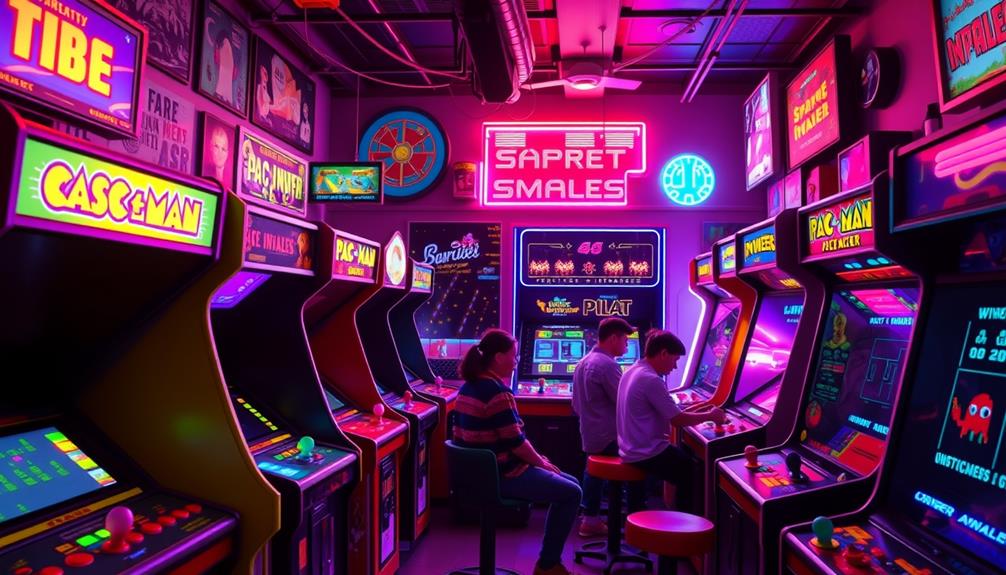
Revolutionizing the gaming landscape, pioneering arcade games laid the foundation for the industry we recognize today.
These arcade hits not only entertained but also shaped how games are designed and played. You might be surprised at how these influential titles changed everything:
- Computer Space (1971): The first commercial arcade machine that introduced interactive gaming through simple space combat.
- Pong (1972): The most famous video game that popularized the arcade format and competitive gameplay, influencing the rise of home consoles.
- Pac-Man (1980): This iconic maze chase game transformed the landscape with non-violent gameplay and power-ups, becoming a cultural phenomenon.
Each of these pioneering games brought unique mechanics and ideas to the forefront, sparking trends that continue to resonate in modern gaming.
From competitive high scores in Space Invaders to character-driven narratives in Donkey Kong, these titles paved the way for innovation and creativity.
As you play today's games, remember the impact these classics had in shaping the gaming world, proving that sometimes, the simplest concepts can change everything.
Notable Racing Games
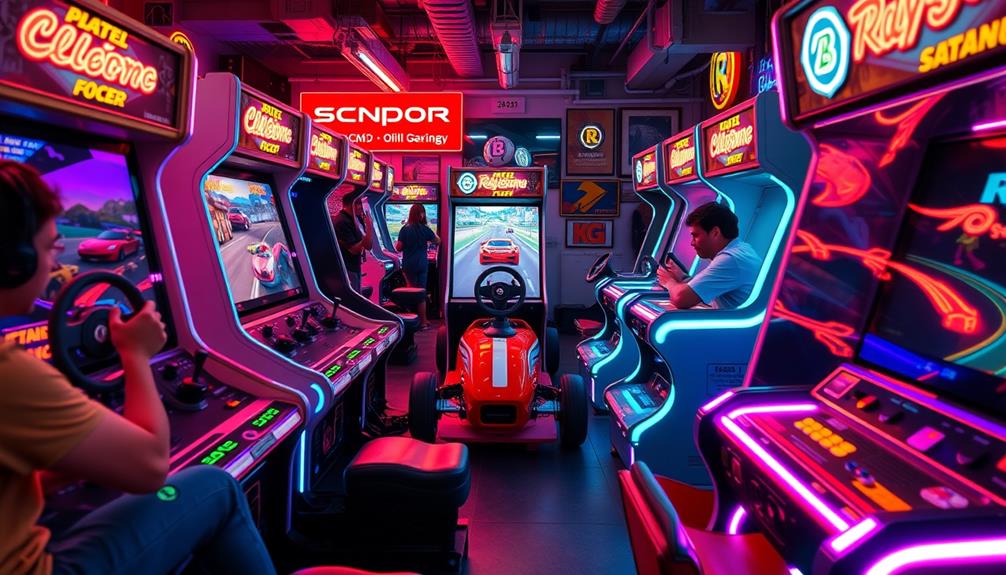
When you think of arcade gaming, racing games often come to mind as some of the most exhilarating experiences you can find. Classics like Pole Position (1982) laid the groundwork for the genre, offering a real steering wheel and pedal setup that brought a taste of realism to the arcade.
Fast forward to Out Run (1986), which wowed players with its catchy soundtrack and introduced a deluxe moving cabinet for an immersive driving simulation.
In 1994, Sega Rally took the arcade world by storm, featuring realistic force-feedback steering wheels and muddy tracks that made you feel like you were really racing.
That same year, Cruis'n USA dazzled players with vibrant graphics and the thrill of racing across iconic U.S. locations, making it a staple in many arcades.
Don't forget Daytona USA (1994), which set new standards with its high-quality 3D graphics and the ability for up to 8 players to compete simultaneously.
These notable racing games not only defined arcade racing but also left a lasting legacy that continues to influence game design today.
Legendary Fighting Games
Arcade gaming isn't just about racing; it's also home to some of the most iconic fighting games that have shaped the genre. Street Fighter II (1991) stands out as a benchmark, introducing accessible special moves and a diverse cast of characters that transformed competitive play. This game set the standard for future fighting games, influencing countless titles.
Another legendary entry is Mortal Kombat (1992). Known for its graphic violence and unique Fatality finishing moves, it sparked controversy and became a cultural phenomenon. The game's popularity led to numerous sequels and adaptations.
You can't forget about Tekken (1994), which brought 3D fighting to the forefront. Its deep combat system and character customization made it a staple in arcades and competitive circuits.
Here are a few more notable titles in the fighting game genre:
- Virtua Fighter (1993), pioneering realistic movement.
- Marvel vs. Capcom Series, known for its tag-team mechanics.
- Guilty Gear, which introduced unique anime-style visuals.
These games not only entertained but also defined the fighting game landscape, making them significant in video game history.
Unique and Creative Concepts
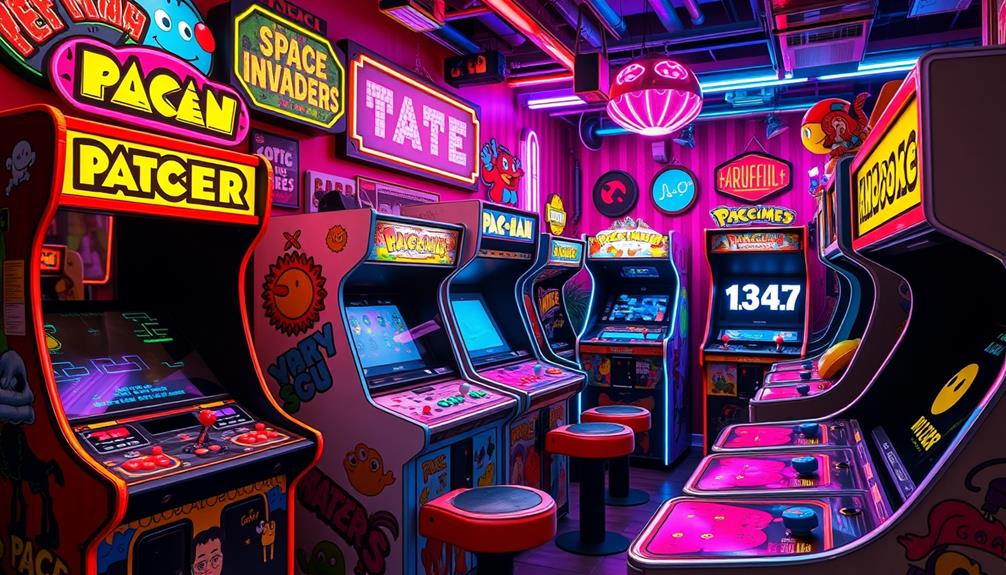
In the domain of gaming, unique and creative concepts have often set certain titles apart from the rest. Take Joust (1982), for instance. The game popularized competitive two-player gameplay with its quirky premise of knights riding flying ostriches. This creative gameplay not only captivated players but also left a lasting mark on arcade history.
Another standout is Cho Chabudai Gaeshi! (2009), which features an outrageous concept where players physically flip a full-sized table peripheral in-game. This level of interactivity showcases a bold approach to arcade game design.
Similarly, Tempest (1981) introduced a unique 3D tunnel shooting mechanic that revolutionized the shooter genre and influenced future designs.
You can't overlook Guitar Freaks (1998), either, which shifted the focus from real musicianship to button pressing, initiating the plastic instrument gaming trend.
Finally, Frogger (1981) stands out for its simple yet innovative gameplay, where you navigate through traffic and rivers, exemplifying the creativity of game mechanics in its era.
These titles demonstrate how unique concepts and creative gameplay can elevate an arcade game into a classic.
Frequently Asked Questions
What Are the Most Popular Old Arcade Games?
When considering the most popular old arcade games, you can't overlook Pac-Man, Donkey Kong, and Street Fighter II. Each game shaped the gaming landscape, offering unique gameplay experiences that still resonate with players today.
What Is the Most Common Arcade Game?
Did you know Pac-Man's sold over 400,000 units since 1980? It's the most common arcade game, enchanting players with its unique maze gameplay, colorful graphics, and iconic sounds that keep you coming back for more.
Which Classic Arcade Game Do People Love Most?
You might find that many people love Pac-Man the most. Its addictive gameplay, iconic design, and cultural significance resonate deeply, capturing the hearts of both nostalgic players and new gamers discovering its charm for the first time.
Which Is the Best Arcade Game?
When you think about the best arcade game, memories of intense battles in Street Fighter II flash in your mind. Its mechanics, characters, and special moves redefine gaming, making it a timeless classic you can't ignore.
Conclusion
Classic arcade games hold a special place in our hearts, bringing joy and nostalgia to countless players. Did you know that over 100,000 arcade machines were sold annually in the 1980s? That statistic reflects the immense impact these games had on our culture, creating unforgettable memories and friendships. So, whether you're reliving those pixelated adventures or introducing them to a new generation, the spirit of classic arcade gaming will always be a cherished part of our lives.
